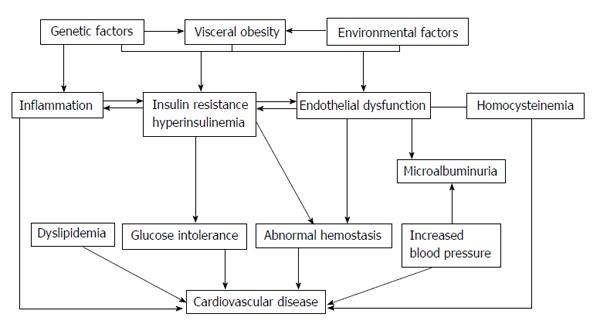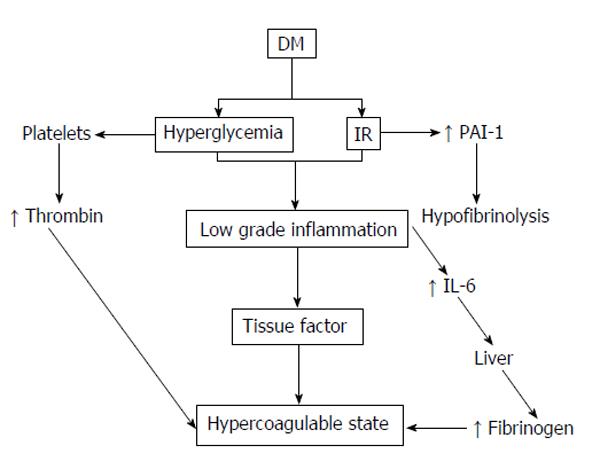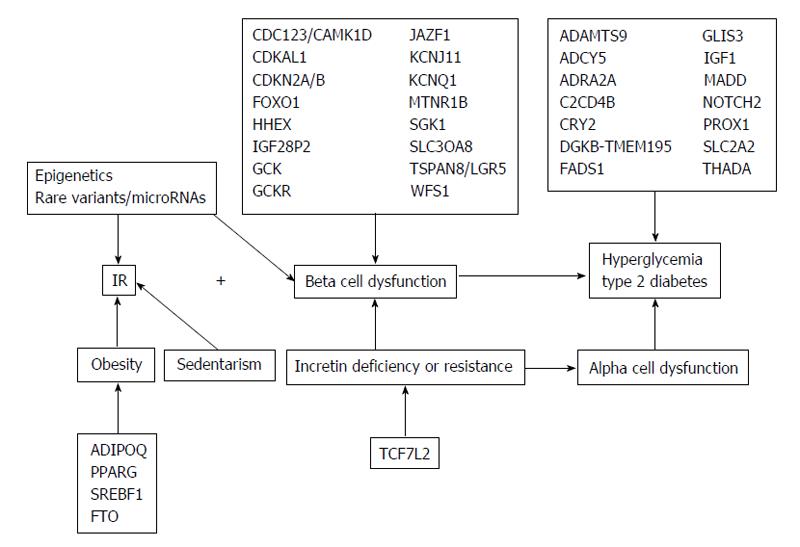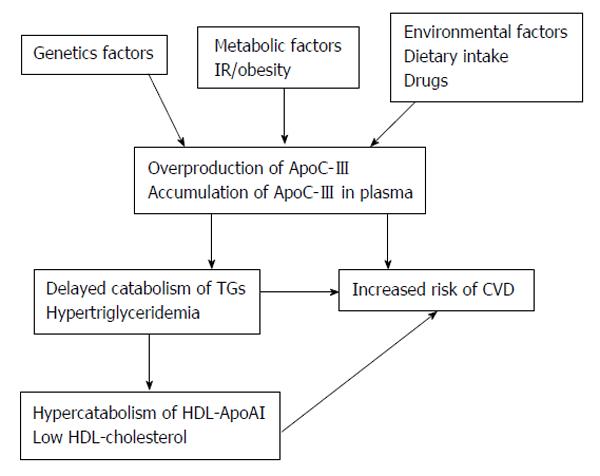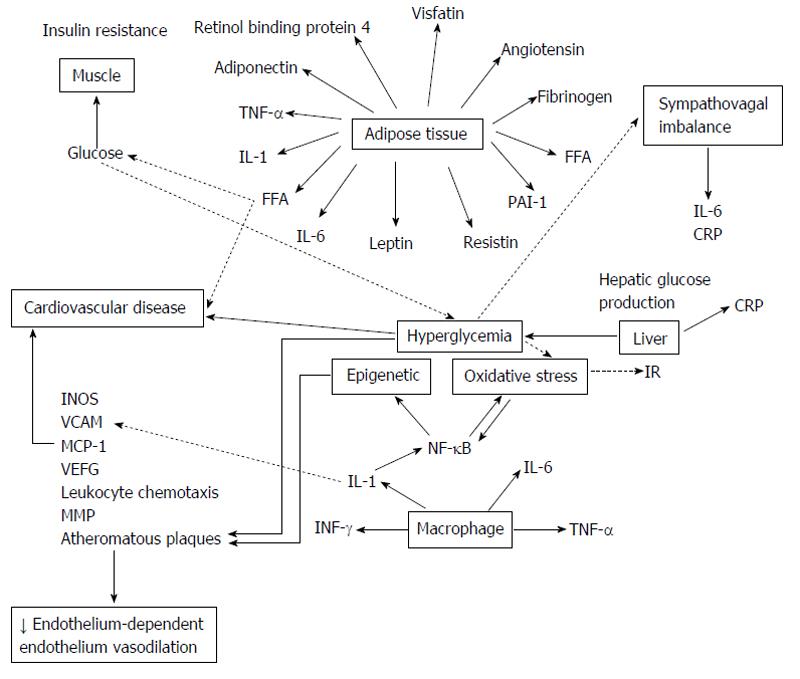Copyright
©2014 Baishideng Publishing Group Inc.
World J Diabetes. Aug 15, 2014; 5(4): 444-470
Published online Aug 15, 2014. doi: 10.4239/wjd.v5.i4.444
Published online Aug 15, 2014. doi: 10.4239/wjd.v5.i4.444
Figure 1 Interactions of traditional and non-traditional risk factors in diabetes mellitus.
Figure 2 Prothrombotic mechanisms in diabetes mellitus.
The hypercoagulable state related with diabetes mellitus is consequent to improved thrombin generation by platelets, impaired fibrinolysis due to increased levels of plasminogen activator inhibitor type 1 (PAI-1), and low-grade inflammation, that rise circulating levels of interleukin-6 (IL-6), fibrinogen, and tissue factor expression in vascular cells. DM: Diabetes mellitus; IR: Insulin resistance.
Figure 3 Possible mechanisms of confirmed and potential risk single-nucleotide poly morphisms in type 2 diabetes.
Many single-nucleotide poly morphisms (SNPs) affect pancreatic beta-cell function. Gene symbols represent SNPs in or near these gene loci. Likely epigenetic alterations microRNAs and/or rare genetic variants also have a critical role. The mechanisms by which some genes increase the risk of diabetes are not yet know. CDC123: Cell division cycle 123; CAMK1D: Calmodulin-dependent protein kinase 1D; CDKAL1: CDK5 regulatory subunit-associated protein 1-like 1; CDKN2A/B: Distal to the genes cyclin-dependent kinase inhibitors 2A; FOXO1: Fork head box protein O1; HHEX: IDE-near hematopoietically expressed home box and insulin degrading enzyme; IGF2BP2: IGF2 mRNA binding protein 2; GCK: Glucokinase; GCKR: Glucokinase regulator; JAZF1: Juxtaposed with another zinc kinger protein 1; KCNJ11: Potassium inwardly-rectifying channel, subfamily J, member 11; KCNQ1: Potassium voltage-gated channel, KQT-like subfamily, member 1; MTNR1B: Melatonin receptor 1B; SGK1: Serum/glucocorticoid regulated kinase 1; SLC30A8: Solute carrier family 30 (zinc transporter) member A8; TSPAN8: Tetraspanin 8; LGR5: Leucine-rich repeat-containing G protein-coupled receptor 5; WFS1: Wolfram syndrome 1; ADAMTS9: Disintegrin and metalloproteinase with thrombospondin motifs 9; ADCY5: Adenylate cyclase 5; ADRA2A: Adrenergic, alpha-2A-, receptor; C2CD4B: C2 calcium-dependent domain containing 4B; CRY2: Cryptochrome 2; DGKB: Diacylglycerol kinase beta 90 kDa; TMEM195: Transmembrane protein 195; FADS1: Fatty acid desaturase 1; GLIS3: GLIS family zinc finger 3; IGF1: Insulin-like growth factor 1; MADD: MAP kinase-activating death domain; NOTCH2: Notch homolog protein 2; PROX1: Prospero-homebox 1; SLC2A2: Solute carrier family 2, member A2; THADA: Thyroid adenoma associated; ADIPO: Adiponectin; PPARG: Peroxisome proliferator-activated receptor-gamma; SREBF1: Sterol regulatory element-binding transcription factor 1; FTO: Fat mass and obesity-associated; TCF7L2: Transcription factor 7-like 2; IR: Insulin resistance.
Figure 4 Dysregulation of apolipoprotein C-III transport as a central cause of cardiovascular disease.
Apo: Apolipoprotein; TGs: Triglycerides; HDL: High density lipoprotein; CVD: Cardiovascular disease; IR: Insulin resistance.
Figure 5 Pathogenesis of cardiovascular disease in diabetes.
The mechanisms implicated in the pathogenesis of cardiovascular disease in diabetes comprehend epigenetic changes and intracellular metabolic changes that result in oxidative stress, low-grade inflammation, and endothelial dysfunction. CRP: C-reactive protein; FFA: Free fatty acids; INOS: Inducible nitric oxide synthase; IL-1: Interleukin 1; MCP-1: Monocyte chemoattractant molecule 1; MMP: Matrix metalloproteinase; NF-κB: Nuclear factor kappa-β; PAI-1: Plasminogen activator inhibitor-1; VCAM: Vascular cell adhesion molecule; VEFG: Vascular endothelial growth factor; TNF-α: Tumor necrosis factor-α; INF-γ: Interferon-γ; IR: Insulin resistance.
- Citation: Martín-Timón I, Sevillano-Collantes C, Segura-Galindo A, Cañizo-Gómez FJD. Type 2 diabetes and cardiovascular disease: Have all risk factors the same strength? World J Diabetes 2014; 5(4): 444-470
- URL: https://www.wjgnet.com/1948-9358/full/v5/i4/444.htm
- DOI: https://dx.doi.org/10.4239/wjd.v5.i4.444









